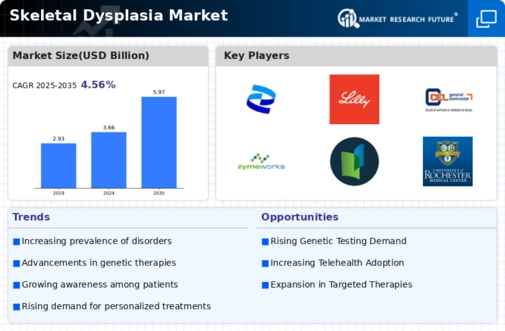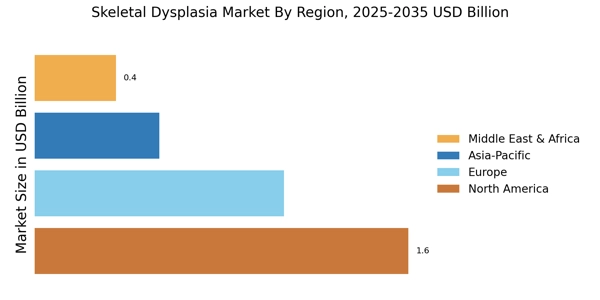Advancements in Genetic Research
Advancements in genetic research are transforming the landscape of the Skeletal Dysplasia Market. The identification of specific genetic mutations associated with various forms of skeletal dysplasia has opened new avenues for targeted therapies. For instance, the discovery of mutations in the FGFR2 gene has led to the development of therapies aimed at addressing the underlying causes of certain dysplasias. This progress not only enhances treatment efficacy but also fosters a deeper understanding of the disease mechanisms. As research continues to evolve, the potential for innovative treatment options increases, thereby attracting investment and interest in the Skeletal Dysplasia Market. Furthermore, collaborations between academic institutions and pharmaceutical companies are likely to accelerate the pace of discovery, leading to the introduction of novel therapies that could significantly improve patient outcomes.
Increased Awareness and Advocacy
Increased awareness and advocacy for skeletal dysplasia are crucial drivers of the Skeletal Dysplasia Market. Organizations dedicated to educating the public and healthcare professionals about these conditions are emerging, which helps in early diagnosis and intervention. This heightened awareness is likely to lead to an increase in patient referrals to specialized clinics, thereby expanding the market. Advocacy groups are also instrumental in pushing for policy changes that support research funding and access to treatments. As more individuals become informed about skeletal dysplasia, the demand for specialized care and innovative therapies is expected to rise, further propelling the Skeletal Dysplasia Market. The collective efforts of these organizations contribute to a more informed public, which is essential for improving patient outcomes and driving market growth.
Technological Innovations in Treatment
Technological innovations in treatment modalities are significantly influencing the Skeletal Dysplasia Market. The advent of advanced imaging techniques and minimally invasive surgical procedures has improved the diagnosis and management of skeletal dysplasia. For example, 3D printing technology is being utilized to create customized implants and prosthetics for patients, enhancing their quality of life. Additionally, the integration of telemedicine is facilitating access to specialists for patients in remote areas, thereby broadening the market reach. These technological advancements not only improve patient outcomes but also attract investment in the Skeletal Dysplasia Market. As healthcare providers adopt these innovative solutions, the demand for new therapies and treatment options is likely to increase, further driving market growth.
Rising Prevalence of Skeletal Dysplasia
The increasing prevalence of skeletal dysplasia is a pivotal driver for the Skeletal Dysplasia Market. It is estimated that skeletal dysplasia affects approximately 1 in 4,000 live births, leading to a significant number of patients requiring specialized care. This rising incidence necessitates the development of targeted therapies and interventions, thereby propelling market growth. As awareness of skeletal dysplasia expands, healthcare providers are more likely to diagnose and treat these conditions effectively. The demand for innovative treatment options, including gene therapy and personalized medicine, is likely to surge, further stimulating the Skeletal Dysplasia Market. Additionally, the growing number of healthcare facilities equipped to handle such cases contributes to the overall market expansion, as more patients gain access to necessary treatments.
Growing Investment in Rare Disease Research
Growing investment in rare disease research is a significant driver for the Skeletal Dysplasia Market. As stakeholders recognize the unmet needs of patients with skeletal dysplasia, funding for research initiatives is on the rise. This influx of capital is likely to accelerate the development of new therapies and treatment options tailored to these rare conditions. Pharmaceutical companies are increasingly focusing on orphan drugs, which are designed to treat rare diseases, including various forms of skeletal dysplasia. This trend not only enhances the therapeutic landscape but also encourages collaboration between industry and academia, fostering innovation. As research progresses, the Skeletal Dysplasia Market is expected to benefit from the introduction of novel therapies that could improve patient outcomes and quality of life.


















Leave a Comment